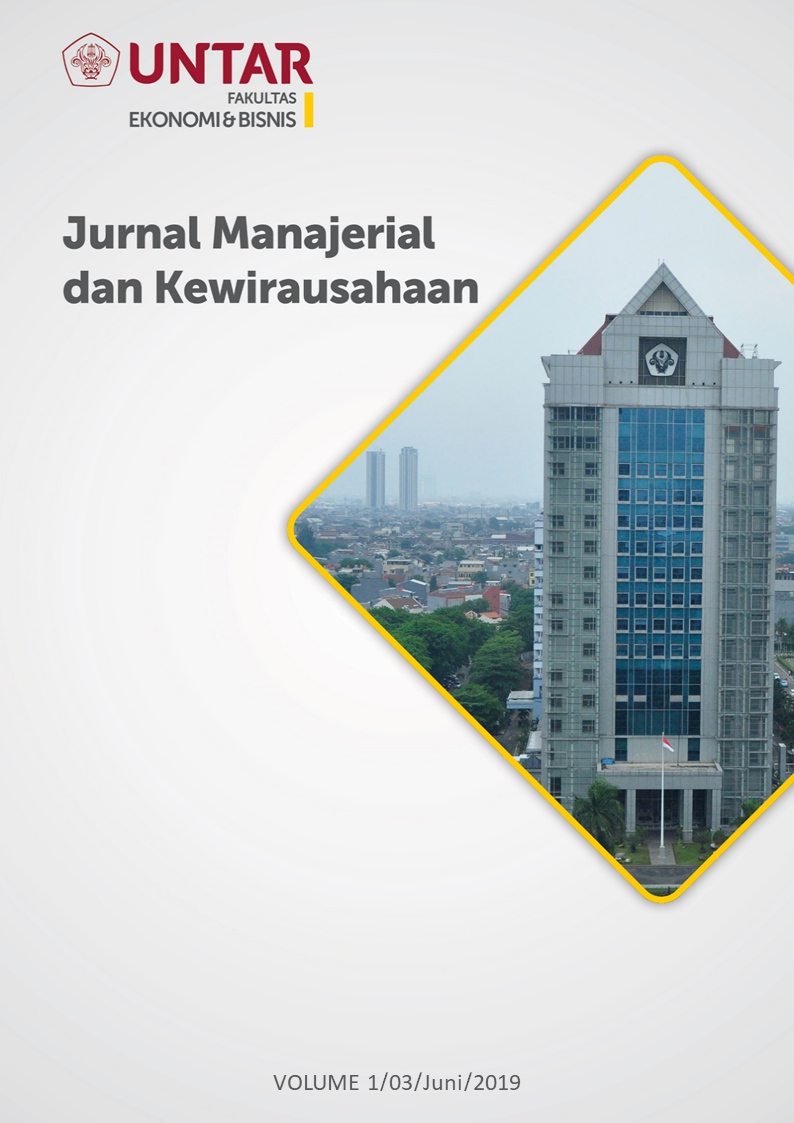Mulut Ke Mulut Dan Citra Merek Untuk Memprediksi Niat Beli Pada Konsumen Laptop Asus Di Fakultas Ekonomi Universitas Tarumanagara
Main Article Content
Abstract
This study aims to examine empirically the function of electronic word of mouth and brand image as a predictor of purchase intentions through Asus laptops. The sampling technique is non-random convenience technique. The sample in this study was Tarumanagara students who had used Asus with 100 respondents. Data collection techniques used through googleform. The data analysis technique used is the analysis of partial least square, normal multivariate, measurement models and structural models. The data analysis tool used is Smart Pls version 3.0. The results of the analysis concluded that electronic word of mouth and brand image were positive predictors of purchase intention
Penelitian ini bertujuan untuk menguji secara empiris fungsi mulut ke mulut elektronik dan citra merek sebagai predictor terhadap niat beli melalui laptop Asus. Teknik pengambilan sampel adalah teknik tak acak convenience. Sampel dalam penelitian ini adalah mahasiswa/i Tarumanagara yang pernah menggunakan Asus dengan jumlah responden 100 orang. Teknik pengumpulan data yang digunakan melalui googleform. Teknik analisis data yang dipakai adalah analisis partial least square, normal multivariate, model pengukurand dan model struktural. Alat analisis data yang digunakan adalah Smart Pls versi 3.0. Hasil analisis menyimpulkan bahwa mulut ke mulut elektronik dan citra merek merupakan prediktor yang positif terhadap niat beli.
Article Details
This work is licensed under a Jurnal Muara Ilmu Ekonomi dan Bisnis Creative Commons Attribution-ShareAlike 4.0 International License.,/p>
References
Aaker D.A. (1996). Measuring brand equity across products and markets.
California Management Review, 38(3), 102–120.
Abdillah, W. dan J. Hartono. (2015). Partial Least Square (PLS): Alternatif
Structural Equation Modeling (SEM) Dalam Penelitian Bisnis. Yogyakarta:
Andi.
Arikunto, S., (2006). Prosedur Penelitian Suatu Pendekatan Praktik. Jakarta:
Rineka Cipta.
Aritonang R., Lerbin R. (2005). Kepuasan pelanggan. Jakarta: PT Gramedia
Pustaka Utama.
______ (2007). Riset pemasaran. Teori & praktik. Bogor: Ghalia Indonesia.
______ (2009). Peramalan bisnis. Bogor: Ghalia Indonesia.
______ (2016). Citra, kesetiaan, kepuasan, kepercayaan dan intensi nasabah bank.
Research report. Jakarta: LPPI Universitas Tarumanagara.
Bambauer-Sache, S. and Manglod, S. (2011), Brand equity dilution through
negative online word-of-mouth communication, Journal of Retailing and
Consumer service services, 18, 38-45.
Chan, S. (2003). Relationship Marketing. Jakarta: PT Gramedia
Christie, C.N. (2016). Analisis pengaruh electronic word of mouth dan citra merek
terhadap pembelian ulang pada merek smartphone samsung dan iphone.
Program Studi Manajemen, Fakultas Ekonomi, Universitas Atma Jaya
Yogyakarta, 12,1-15.
Chen, Fang,M., and Lee,C.L. (2015). The impacts of green claims on coffee
consumers’ purchase intention. British Food Journal, 17(1), 195-209.
Chin, W. W. (1998). The partial least squares approach to structural equation
modeling. Modern methods for business research. New York: Lawrence
Earlbaum Associates.
Davis, D.F., Golicic, S.L. and Marquardt, A. (2009), Measuring brand equity for
logistic services, International Journal of Logistics Management, 20(2) ,
-212
Djatmiko, T., and Pradana, R. (2016). Brand Image and product price; its impact
for samsung smartphone purchasing decision. Procedia - Social and
Behavioral Sciences, 219, 221-227.
El-Baz, R. I. (2016). Electronic word of mouth effects on consumers’ brand
attitudes, brand image and purchase intention: an empirical study in egypt.
The Business and Management Review, 7(5), 268-276.
Gadhafi, M. (2015). Pengaruh electronic word of Mouth terhadap niat pembelian
yang dimediasi oleh citra merek pada produk laptop acer di surabaya.
Sekolah tinggi ilmu ekonomi perbanas, 107, 1-21.
Ghozali, Imam. 2006, Structural Equation Modeling Metode Alternatif dengan
Partial Least Square, (Edisi ke 1). Semarang: Universitas Diponegoro.
Ghozali, Imam. (2014). Structural Equation Modeling, Metode Alternatif dengan
Partial Least Square (PLS). (Edisi ke 4). Semarang:Universitas
Diponegoro.
Hair, J.F., Ringle, C.M. and Sarstedt, M. (2011) PLS-SEM: indeed a silver bullet.
Journal of Marketing Theory and Practice, 19, 139-151.
Juliana. (2018). pengaruh komunikasi dari mulut ke mulut terhadap citra merek dan
reputasi perusahaan serta dampaknya pada nilai pelanggan. Fakultas
Ekonomi dan Ilmu Sosial Universitas Islam Negeri Sultan Syarif Kasim
Riau, Indonesia, 6(3), 1-10.
Lee, H., Lee, C., and Wu, C. (2011). Brand image strategy affects brand equity after
M&A. European Journal of Marketing, 45(7/8), 1091-1111.
Malhotra, N. K. (2010). Marketing Research An Applied Orientation (Edisi ke 6).
Pearson. Georgia: Institute of Technology.
Jalilvand, M.R. and Samiei, N.. (2012). The effect of electronic word of electronic
word of mouth on brand image and purchase intention. Marketing
Intelligence & Planning, 30(4), 460-476.
Roscoe, W., and Lambda Alliance (University of Montana). (1975). Will Roscoe
papers. San Francisco: online archive of California.
Schau, H.J. and Gilly, M.C. (2003), We are what we post? Self-presentation in
personal web space, Journal of Consumer Research, 30, 385-404.
Sekaran, U., and Bougie, R. (2013) Research Methods For Business. (Edisi ke 6).
United Kingdom: Wiley.
Shukla, P. (2010), Impact of interpersonal influences, brand origin and brand image
on luxury purchase intentions: measuring interfunctional interactions and a
cross-national comparison, Journal of World Business, 46(2), 242-252.
Sofyan Y., dan Kurniawan H., (2011). Generasi Baru Mengolah Data Penelitian
dengan Partial Least Square Path Modeling: Aplikasi dengan Software
XLSTAT, SmartPLS, dan Visual PLS. Jakarta: salemba infotek.
Sugiyono. (2011). Metode Penelitian Kuantitatif Kualitatif, dan R&D (cetakan ke14). Bandung: Alfabeta.
Teng, H., Ni, J., and Chen, H. (2018). Relationship between e-servicescape and
purchase intention among heavy and light internet users. Internet
Research, 28(2), 333-350.
Torlak, O., Ozkara, B. Y., Tiltay, M. A., Cengiz, H., and Dulger, M. F. (2014). The
effect of electronic word of mouth on brand image and purchase intention:
an application concerning cell phone brands for youth consumers in turkey.
Journal of Marketing Development and Competitiveness, 8(2), 61-68.
Torlak, Ozkara, Tiltay, Cengiz, and Dulger,lseidi, R. i., and EL-baz, D. (2016).
Electronic word of mouth effects on consumers’ brand attitudes, brand
image and purchase intention: an empirical study in Egypt. The Business
and Management Review, 7(5), 1-10



